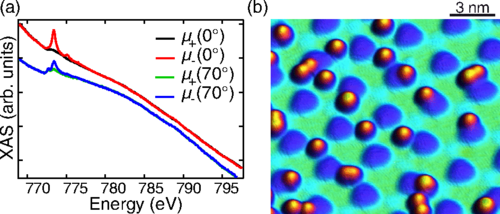November 4, 2014 report
Researchers find magnetic state of atoms on graphene sheet impacted by substrate it's grown on

(Phys.org) —A team of researchers working in Switzerland with members from institutions in that country, the U.S. and Germany has found that the magnetic state of atoms placed on a graphene sheet are impacted by the type of metal substrate the graphene was grown on. In their paper published in the journal Physical Review Letters, the researchers describe their research and suggest ways that their findings could be used in future computing devices.
While studying cobalt atoms placed on a sheet of graphene, the researchers noted that it had a magnetization that was in-plane (across the sheet)—later they found that graphene that had been grown on a ruthenium substrate, resulted in the cobalt atom having a magnetism that was out-of-plane. This meant, they found after more testing, that the magnetization of atoms places on sheets of graphen are in general impacted by the type of metal that was used as the initial substrate. This finding may have implications for spintronic devices which rely on the spin states of atoms (in addition to charge) because it means that the magnetism can be customizable.
In looking closer, the researchers found that the bonds that formed between carbon atoms and its substrate were weaker or stronger depending on the type of metal substrate used. When Ru was used, for example, strong bonds occurred, whereas when Ir or Pt were used, both exhibited extremely weak bonds. What this means, the researchers explain, is that the carbon atoms were closer or farther from the metal atoms, depending on the type of metal used, which in turn meant that the electrons that were transferred to or from the carbon were impacted as well. The end result is different types of graphene sheets being created.
The question now is how long can the magnetic state last—if long enough, since they can be customized—it might lead to them being used as electronic storage media, with a single atom being used to represent a single bit of data (currently it takes approximately 107 atoms to store one bit on a hard-drive). Or they could perhaps be used to represent quantum bits. Because of that, the team has now set its sights on uncovering which single atoms hold their magnetic state the longest.
More information: Tailoring the Magnetism of Co Atoms on Graphene through Substrate Hybridization, Phys. Rev. Lett. 113, 177201 – Published 20 October 2014. dx.doi.org/10.1103/PhysRevLett.113.177201
ABSTRACT
We determine the magnetic properties of individual Co atoms adsorbed on graphene (G) with x-ray absorption spectroscopy and magnetic circular dichroism. The magnetic ground state of Co adatoms strongly depends on the choice of the metal substrate on which graphene is grown. Cobalt atoms on G/Ru(0001) feature exceptionally large orbital and spin moments, as well as an out-of-plane easy axis with large magnetic anisotropy. Conversely, the magnetic moments are strongly reduced for Co/G/Ir(111), and the magnetization is of the easy-plane type. We demonstrate how the Co magnetic properties, which ultimately depend on the degree of hybridization between the Co 3d orbitals and graphene π bands, can be tailored through the strength of the graphene-substrate coupling.
via Nanotechweb
Journal information: Physical Review Letters
© 2014 Phys.org



















